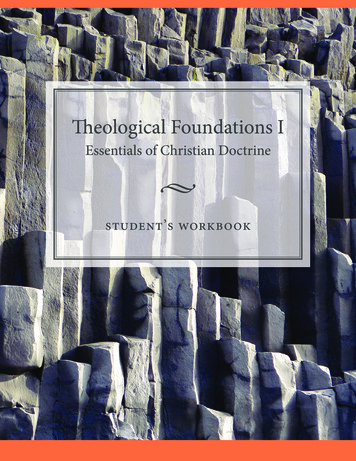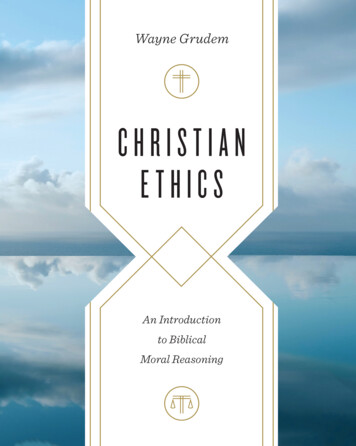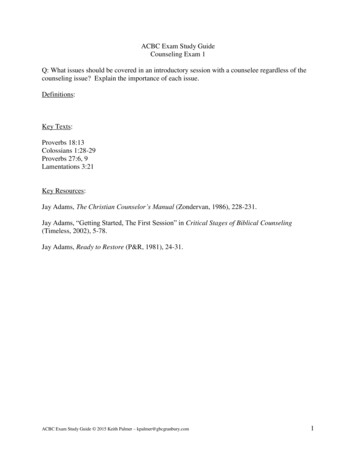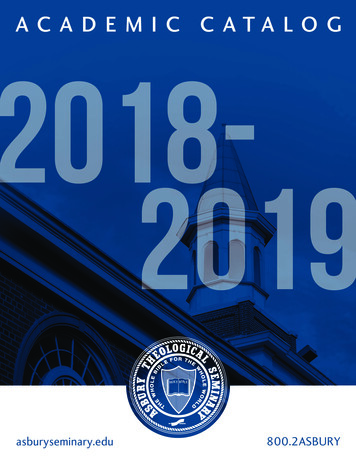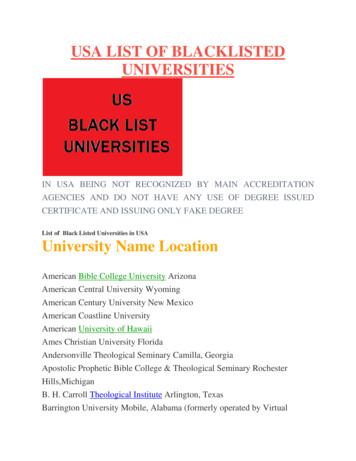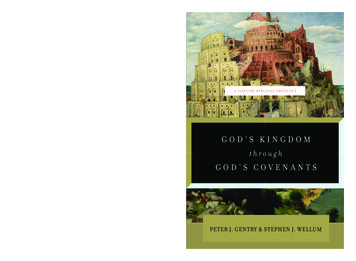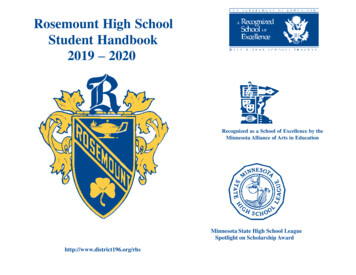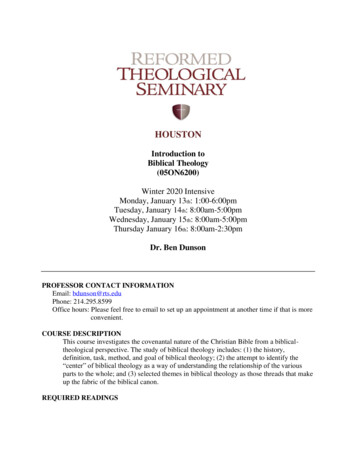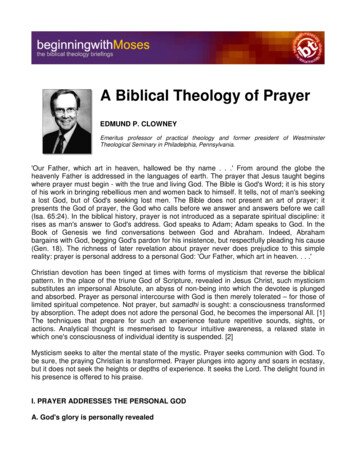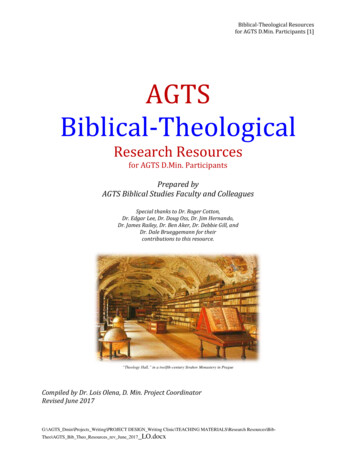
Transcription
Biblical-Theological Resourcesfor AGTS D.Min. Participants [1]AGTSBiblical-TheologicalResearch Resourcesfor AGTS D.Min. ParticipantsPrepared byAGTS Biblical Studies Faculty and ColleaguesSpecial thanks to Dr. Roger Cotton,Dr. Edgar Lee, Dr. Doug Oss, Dr. Jim Hernando,Dr. James Railey, Dr. Ben Aker, Dr. Debbie Gill, andDr. Dale Brueggemann for theircontributions to this resource.“Theology Hall,” in a twelfth-century Strahov Monastery in PragueCompiled by Dr. Lois Olena, D. Min. Project CoordinatorRevised June 2017G:\AGTS Dmin\Projects Writing\PROJECT DESIGN Writing Clinic\TEACHING MATERIALS\Research Resources\BibTheo\AGTS Bib Theo Resources rev June 2017 LO.docx
Biblical-Theological Resourcesfor AGTS D.Min. Participants [2]CONTENTSYour D.Min. Project Chapter 2: Where to Begin?. 4Step 1: Determine the theological or topical themes and key biblicaltexts that inform the topic of your D.Min. project . 5Instructional Documents for Step 1 .Studying a Theme of Old Testament Theology (Cotton) .Guidelines for Biblical-Theological Papers (Oss) .Redemptive-Historical Unfolding (Oss) .56712Bibliographic Sources for Step 1 . 15Bible Dictionaries and Encyclopedias. 15Biblical Theological Reflection on the Church and Ministry . 16Step 2: Address the texts yourself to gain a panoramic view. . 20Instructional Documents for Step 1 .Basic Exegesis Guidelines (Cotton).Doing Word Studies in the Bible (Cotton) .Instructions for Doing Old Testament Word Studies (Cotton) .How to do a New Testament Word Study (Hernando) .Flow Chart for Doing Word Studies on Bible Words in the OT (Cotton) .202122242629Bibliographic Sources for Step 2 .Bible Versions—English.Study Bibles .Understanding Bible Translations (Oss) .Concordances .Background History and Culture Studies .Exegetical Methodology .Basic Bibliography for Biblical Interpretation (Oss) .Word Books/Theological Dictionaries .Old Testament .New Testament.Lexicons .Biblical Theologies .General .Old Testament Theology .New Testament Theology .30303030313131333636363738384148G:\AGTS Dmin\Projects Writing\PROJECT DESIGN Writing Clinic\TEACHING MATERIALS\Research Resources\BibTheo\AGTS Bib Theo Resources rev June 2017 LO.docx
Biblical-Theological Resourcesfor AGTS D.Min. Participants [3]Step 3: Consult commentaries to zoom in and do morein-depth analysis . 53Instructional Documents for Step 3 . 53Billings, J. Todd. “How to Read the Bible.” Christianity Today. October 27, 2011, 24-30.This article is not included in this document but is available upon request. It includes asection on commentaries, as well as a list of commentary resources at theend.Making Use of Indices and Abstracts (Hernando). 54Bibliographic Sources for Step 3 .Commentaries .Surveys of Commentaries.Sets .One-Volume Commentaries .5858585858Old Testament . 60Recommended OT Commentary List (Cotton). 61Recommended OT Commentary List (Brueggemann) . 65New Testament. 68Systematic Theology Resources (Railey) .General .Arminian/Wesleyan .Lutheran .Neo-Orthodox/Modern Continental .Pentecostal/Charismatic ther . 88Difficult QuestionsJournalsEssays in books that are collections of essaysSpecialized scholarly books on a focused topicDissertationsOnline Study AidsStep 4: Synthesize your research and write chapter 2.G:\AGTS Dmin\Projects Writing\PROJECT DESIGN Writing Clinic\TEACHING MATERIALS\Research Resources\BibTheo\AGTS Bib Theo Resources rev June 2017 LO.docx
Biblical-Theological Resourcesfor AGTS D.Min. Participants [4]Your D.Min. Project Chapter 2: Where to Begin?Your chapter 2 should provide the biblical foundation (motivation, basis) for your ministry intervention.Sometimes it’s difficult to know where to begin to achieve that end. The table below will help you begin. Beforeyou delve into the excellent resources available in this document, take time to review the table below regardingsteps to take to begin the biblical-theological literature review (chapter 2) of your project. These steps andrecommended key texts will help you work from a broad topic to a narrow one. The rest of the document containsboth instructional documents and lists of sources relative to the steps listed below.NOTE: *The triangle below represents going from the broad (at the top) to the specific (at the bottom) inresearching for chapter 2. You do not need to present all your research from each of these steps in chapter 2 ofyour D.Min. Project; rather, your chapter will serve as the “tip of the iceberg” (see below) that synthesizes yourfindings from these fundamental biblical-theological research resources.STEP*(1) DetermineTheologicalor topicalthemes andkeybiblical textsthat inform thetopic of yourD.Min.project.(2) Addressthe textsyourself togain apanoramicoverview.TYPE OF RESOURCESBiblical/Topical/TheologicalDictionaries or EncyclopediasThese will give you the nomenclatureneeded for your subject matter.SUGGESTED TEXTS New Dictionary of Biblical Theology, ed. Rosner, Alexander, Goldsworthy,Carson. ISBE (The International Standard Bible Encyclopedia) 4 Vols. ed. Bromiley ISBE 1939 edition is free online. NIDB (New Interpreter’s Dictionary) 5 Vols. Anchor Bible Dictionary (left of Evang.) 6 Vols., ed. Freedman HarperCollins Bible Dictionary, 3rd rev., ed. PowellSECOND LAYER: IVP Dictionaries (see all) Baker’s Dictionary of Practical TheologyLearn Exegetical Methodology/----------------------Various Bibletranslations,concordances,lexicons,word studies,texts to gain thehistorical/cultural/literaryunderstandingof the text(3) Consultcommentariesto zoom in anddo more indepthanalysis. (Usethese toconfirm orcontrast withyourdiscoveries.)Commentaries-Build abibliography ofsources onyour texts(4) Synthesizeyour research.WriteChapter2-journalsStuart, Old Testament ExegesisFee, New Testament Exegesis (includes a resource for pastors)Vhymeister, Quality Research Papers – Chapter 13, on ExegesisDictionary of Biblical Imagery (IVP)The Oxford Encyclopedia of Archaeology in the Near East (5 Vols.)HALOT (The Hebrew and Aramaic Lexicon of the Old Testament) – currentstandardHolladay (A Concise Hebrew and Aramaic Lexicon of the Old Testament)NIDOTTE (New Intl. Dictionary of OT Theology and Exegesis), ed. VanGemeren;TWOT (Theological Wordbook of the Old Testament) ed. Archer, Harris, WaltkeBDB (Brown-Driver-Briggs Hebrew and English Lexicon) – old standard; still goodNIDNTTE (New Intl. Dictionary of NT Theology and Exegesis) ed. Silva, 2014NIDNTT (New Intl. Dictionary of NT Theology: Abridged), ed. VerbruggeBDAG (A Greek-English Lexicon of the New Testament and Other Early ChristianLiterature) ed. (Bauer, Danker, Arndt, Gingrich)Longman, Survey of OT Commentaries, 5th ed, 2013Carson, Survey of NT Commentaries, 7th ed., 2013NIVAC (New International Version Application Commentary) 20 Vols.Indices (HUM & RELG; see Hernando)OT and NT abstracts (tied to text or topic) via ATLAOxford Encyclopedia of ArchaeologyAlso: essays/chapters in books; monographs (On Christological hermeneutics:Graeme Goldsworthy, Sidney Greidanus, Edmund P. Clowney), dissertations-HistoricalTheology(biblical &ecclesial)only ifnecessarySynthesis Chapter 2Research G:\AGTS Dmin\Projects Writing\PROJECT DESIGN Writing Clinic\TEACHING MATERIALS\Research Resources\BibTheo\AGTS Bib Theo Resources rev June 2017 LO.docx
Biblical-Theological Resourcesfor AGTS D.Min. Participants [5]STEP 1Determine the theological or topical themes and key biblical texts that inform the topic of your D.Min. project.Resources: Biblical/topical/theological dictionaries or Encyclopedias. (See chart on page 4 for recommendations.)Refer back to the process on page 4 to steps 1, 2, and 3:determine your relevant themes and key texts,interact with the biblical text yourself, andthen go to a more focused analysis and finally synthesis for the sake of writing your chapter 2.The following section (“Step 1”) includes first some instructional documents relative to this step, and then abibliography of sources within the categories listed on page 4 for this step.Learn how to build a bibliography for your project by understanding what sources will give you a broader view,which will help you engage the text yourself, and which will assist you in analyzing and then synthesizing thematerial you are handling. Take time to understand the focus of each bibliographic section listed below. Wheredoes that type of source fit within the process of your biblical-theological research?As this document is refined each year, the biblical faculty and colleagues of AGTS will attempt to provide for youbibliographies that will be most relevant to the Doctor of Ministry project.Instructional Documents for Step 1 (beginning next page):G:\AGTS Dmin\Projects Writing\PROJECT DESIGN Writing Clinic\TEACHING MATERIALS\Research Resources\BibTheo\AGTS Bib Theo Resources rev June 2017 LO.docx
Biblical-Theological Resourcesfor AGTS D.Min. Participants [6]STUDYING A THEME OF OLD TESTAMENT THEOLOGYby Roger Cotton1. Make sure you have narrowed the theme down to a manageable size for your purpose andhave clearly restricted it to the specific aspects you are really interested in.2. Identify the key words and phrases as well as images, metaphors, and cultural comparisonsused to describe the truths of your theme, from the major passages that deal with it.3. Find every passage that makes any significant contribution to the understanding of yourtheme in the Old Testament from concordances and various sources of cross references. Besure to use the New Englishman's Hebrew concordance, NIV Hebrew-English conc., oranother that lists every place a Hebrew word is used, or a computer program that does thesame, for all the references to the key Hebrew words and phrases involved in your theme.4. List the principles you see in each of the passages, distinguishing the contexts of the variouswriters, genres, and time periods as you do, so that you recognize the different purposes andangles being stressed. Let each writer speak their own contribution in their own context. Youmust do quick but accurate exegesis of each passage.5. Read the word studies done in NIDOTTE; also may want to check TWOT, and TDOT(requires knowledge of Hebrew).6. Research the key words, phrases, and the theme topic in other scholarly literature including:Bible encyclopedias (new ISBE, and ABD); New Dictionary of Biblical Theology; IVPDictionaries of the OT: Pentateuch, History, etc.; Dictionary of Biblical Imagery;monographs; journals; the best exegetical commentaries; Old Testament Theologies(Davidson, Eichrodt, Von Rad, Payne, Martens, House, Waltke, Goldingay, Dyrness); andNIDOTTE, vol 4, Topical Dictionary).7. Compile all the principles or truths you have found to be involved in your theme as you havestudied all the significant passages and what the scholars have observed. Then find a fewbasic, natural, groupings of the principles in order to organize your material. Be aware of theBible writers' categories versus ours.8. Outline the presentation simply, clearly, logically, consistently, using either a natural topicalorder or the order of the canon, the latter showing any progressive revelation, for presentationto a seminary class. Be sure to cite all major supporting scriptures.9. Draw conclusions on what God was saying to Israel then and what principles He wants us toapply to the church today.For an excellent summary of the principles and process of doing Old Testament theology, withillustrations, see essay # 10 in NIDOTTE vol 1, pp. 185-205, “Integrating Old TestamentTheology and Exegesis: Literary, Thematic, and Canonical Issues,” by Richard Schultz.G:\AGTS Dmin\Projects Writing\PROJECT DESIGN Writing Clinic\TEACHING MATERIALS\Research Resources\BibTheo\AGTS Bib Theo Resources rev June 2017 LO.docx
Biblical-Theological Resourcesfor AGTS D.Min. Participants [7]Guidelines for Biblical-Theological PapersDouglas A. Oss1Assemblies of God Theological SeminarySpringfield, MO 65802I. General GuidelinesA. Write a piece of connected prose aimed at an audience of fellow students.B. Follow an acceptable format for footnotes/endnotes, bibliography, spacing, title page,grammar, style, etc.C. Length should be approximately 20 pages.1. Don’t pad or be long-winded; I have to read a lot of papers!2. Don’t feel that you must slight material that is genuinely relevant.3. Length in and of itself has no inherent value for your grade.D. Exegetical Theological Papers1. Include an explanation of any interpretive difficulties.2. Assess the impact the passage had within its immediate literary and redemptivehistorical contexts.3. Explore the canonical redemptive-historical connections and determine thechristocentric bearing of the passage.E. Dogmatic Theological Papers1. Determine why a correct understanding of this issue is important; don’t waste thechurch’s time on foolish and unedifying controversies (I Tim. 1:4; 6:4; Tit. 3:9).2. Explore the canonical material that can properly be brought to bear on this issue.3. Include an explanation of any interpretative difficulties that affect our ability toformulate doctrine on this topic.4. Include any helpful discussion from the history of the church’s approach to this issue.II. The Holy Spirit’s IlluminationThe “doctrine of illumination” refers to the teaching function of the Spirit. Every effort of theChristian scholar must arise from, be sustained by, and bear fruit through the Holy Spirit’sillumination. The starting point for all scholarly papers must therefore be prayer. Let prayerfulsubmission to the Lord and His word characterize your whole theological enterprise ask God togive you sound biblical-theological insight at each step of your research and writing. Thedisciplines of both scholar and saint are yours by calling; they must be joined together your livessince you are charged to feed the flock. Your labor here at AGTS is not merely academic andtemporary, but spiritual and lifelong. Acknowledge God’s grace throughout this process: ask Himfor help, and thank Him when He gives it – He will you know.III. Specific GuidelinesA. Be organized, cogent, and persuasive1. For exegetical theological papers, you may find it useful to develop a separate sectionfor motific analysis.a. This is where biblical theology functions as a method.b. It may be fruitful to pursue a given motif at some length.2. For dogmatic theological papers, you may find it useful to organizeI am indebted to Prof. Vern Poythress (Westminster Theological Seminary, Philadelphia, PA) for portions of thisguideline. For further help read John Frame, The Doctrine of the Knowledge of God (Phillipsburg, NJ: Presbyterianand Reformed, 1987), “Evaluating Theological Writings” (pp. 369-370); “How to Write a Theological Paper” (pp.371-79); and “Maxims for Theologians and Apologists” (pp. 375-79).1G:\AGTS Dmin\Projects Writing\PROJECT DESIGN Writing Clinic\TEACHING MATERIALS\Research Resources\BibTheo\AGTS Bib Theo Resources rev June 2017 LO.docx
Biblical-Theological Resourcesfor AGTS D.Min. Participants [8]your material in ways specifically tailored to the demands of your topic.a. If the issue has been the subject of historical controversial, set out a history of thedebate, analyze and critique the various viewpoints, and conclude with your ownunderstanding of the Bible’s teaching on this matter.b. If the issue has several key facets, determine what they are and treat themmethodically one after another in separate sections.c. If the issue is a matter of current debate, outline the main rival positions, assesstheir respective strengths and/or weakness, and offer your assessment of theBible’s teaching on this matter.B. Things that are essential1. Provide proper and thorough documentation of materials used in research.a. You may use the MLA Handbook, but if you do, you must follow §5.8 forfootnotes or endnotes. Parenthetical embedded citations will not be accepted fordocumentation, and an alphabetized bibliography is a must.b. Kate L. Turabian, A Manual for Writers of Term Papers, Theses, andDissertations is the standard for biblical studies and will be your most helpfulresource for questions about documentation and formatting; she is consistent instyle and gives many examples for both footnote and bibliographical format (seebelow).2. Exercise care in handling your passage in an exegetical theological paper.a. Give due consideration to each verse of the passage.b. Pay attention to how the passage as a whole fits together.c. Focus on the influence the immediate context in the book, both literary andhistorical.d. View the passage in the light of major concerns, emphases, themes, andother illumination provided by the book as a whole (crucial).e. Reflect on any allusions by the human writer to other Scripture passages(essential for a canonical understanding).f. See the whole of Scripture from the point of view of this verse, but in away that acknowledges the remoteness of what is only remotely connected.g. Distinguish what the original human author and audience could haveunderstood from additional connections that we now see in the light of thecompleted canon.3. Exercise care in covering the biblical teaching in a dogmatic theological paper.a. Deal with all the key texts that bear on your doctrinal position.b. Assess each passage’s meaning in its own context to determine itsapplicability to your topic.c. Spell out any complexities that render a sure decision difficult.d. Respect the theological contribution of those who have gone before you inthe church.i. Do not lightly dismiss or ignore the consensus of the Churchthroughout its history.ii. Do not misrepresent even those with whom you differ.1. Do not argue against implications that you attach to someone’sview without determining that they are in fact necessaryimplications of that viewpoint.22. Do not set up a straw man and knock that down rather thanwrestling with your opponent’s theological strengths.e. Be bold where Scripture is clear and cautious where Scripture is vague.2See D.A. Carson, Exegetical Fallacies (Grand Rapids: Baker, 1984), “Logical Fallacies,” pp 91-126.G:\AGTS Dmin\Projects Writing\PROJECT DESIGN Writing Clinic\TEACHING MATERIALS\Research Resources\BibTheo\AGTS Bib Theo Resources rev June 2017 LO.docx
Biblical-Theological Resourcesfor AGTS D.Min. Participants [9]C. Things that are inconsequential1. Whether you discuss at any length harmonistic problems and objections of liberals.2. Whether you go into grammatical minutiae (except as these may bear on a majorinterpretive question).3. Whether you make preaching-type applicants in the body of the paper (may beincluded in a sermon outline section at the end of the paper).4. Whether you provide an extended introduction and discussion of the setting (exceptas these may bear on a major interpretive question).D. Things that may sink your grade1. Majoring on minors.2. Neglecting to comment at all about an important verse.3. Approaching a passage from the framework of systematic theology in a way thatoverwhelms the fine nuances of the passage itself (e.g., reading in systematictheological meaning with no redemptive-historical appreciation).4. Failing to interpret a passage with proper canonical awareness:a. Keeping your eyes too exclusively fixed on one text.i. Missing a key OT background, or background from the book inquestion, for a given verse or topic.ii. Missing a key NT fulfillment.b. Keeping your nose too exclusively on the whole of Scripture.c. Failing to distinguish between the emphasis of an individual text on theone hand and the whole counsel of God on the other hand.d. Failing to show an organic connection between the emphasis of anindividual text on the one hand and the whole counsel of God in on theother hand.5. Giving priority in interpretation to a reconstructed historical situation about whichyou hypothetically suppose the passage to be speaking, rather than to the passageitself as it comes from author to reader.6. Etymologizing, or otherwise using a word study as though it were a method of doingbiblical theology.7. Emphasizing verbal parallels more than conceptual (real) parallels when doingmotific analysis.8. Making a passage speak more definitely and/or precisely than what it will bear.9. Allegorization.IV. Steps in InterpretationA. Exegetical Theological Development1. Preliminary acquaintance with the texta. Memorize the passage (and some context).b. Define the limits of the passage (the NIV paragraphs are generally reliable).c. Pray for the Holy Spirit’s illumination: for insight, courage, and humility tounderstand and present the passage faithfully.d. Read and re-read the passage in the larger literary context of the book. View thewhole of Scripture from the standpoint of this passage and this passage from thestandpoint of the whole of Scripture. Strive for a maximum number of differentperspectives.2. Exegesis in the original setting (observant and interpretation in uniqueness)a. Learn as much as you can about the speaker, the audience, and the circumstancesof the utteranc4e (historical background).b. Check out difficulties with reference tools: commentaries, Bible encyclopedias,atlases, lexicons, grammars, etc.G:\AGTS Dmin\Projects Writing\PROJECT DESIGN Writing Clinic\TEACHING MATERIALS\Research Resources\BibTheo\AGTS Bib Theo Resources rev June 2017 LO.docx
Biblical-Theological Resourcesfor AGTS D.Min. Participants [10]c. Analyze the passage syntactically.d. Outline the passage using whatever forms of outlining are most promising.e. Determine how the passage relates conceptually to its immediate literary context.f. Identify the genre of the text and of larger sections in which it is imbedded.3. Exegesis in the canonical setting (interpretation in relationship to the entire canonand to the unfolding of God’s plan and purpose in redemptive history).a. Locate the passage in its epoch in the history of redemption, and determine itscontribution to revelation at that point.b. Do motific analysisi. Do a motific analysis of your passage in antecedent Scripture.ii. Do a motific analysis of your passage in subsequent Scripture.c. Do a diachronic analysis of the earlier canonical sources and later use of thispassage is Scripture, and its application to various audiences.i. Does your passage quote or allude to a text from an earlier portion of thecanon?ii. Does a later portion of the canon quote or allude to your passage?d. Pick two-five key words and trace their usage through OT and NT.i. Be alert for parallel motifs where these words are used.ii. Be alert also to the fact that every instance of a word will not indicate aparallel motif or concept.e. Use cross-references and other resources to locate passages most similar or mostcontrasting to the given passage.f. Identify theological issues raised or solved.g. Compare the passage with other passages dealing with similar issues.h. Reevaluate exegesis in the light of the canon already available to the originalhearers of the given passage.i. How does the passage preach Christ?j. Assess how differences in redemptive-historical epoch and/or cultural situationwill affect current application.k. Summarize the message of the passage in a single declarative sentence. Try tomake the summary precise enough that a person familiar with the Bible mightguess the passage just from the summary.l. Check your work against exegetical commentaries, especially thoserecommended in class.4. Preparation for preaching (application)a. In interaction with theology, formulate three or four applications to our time, andto yourself.b. Make the applications concrete by forming them in one sentence summaries.c. Adapt the application to your audience. What should they do differently becauseof this passage?d. Choose a principal application. Then work backward from the application to thesermon outline, with the audience constantly in view. Decide whether followingthe text consecutively or motifically would be more effective. Organize theoutline so that each major section is an answer to a question the audience mightwell ask about the principle motif.e. Fill in the outline in detail. Illustrate, do more application, etc.B. Dogmatic Theological Development1. Define the scope of the issue: - You cannot write a worthwhile 10-15 page paper onPneumatology, Christology, Soteriology, or Ecclesiology, that requires a book.2. Collect the relevant biblical data that will help you develop a full grasp of the matter.G:\AGTS Dmin\Projects Writing\PROJECT DESIGN Writing Clinic\TEACHING MATERIALS\Research Resources\BibTheo\AGTS Bib Theo Resources rev June 2017 LO.docx
Biblical-Theological Resourcesfor AGTS D.Min. Participants [11]a. Use a concordance, cross-references, and your memory of the Bible to assemblethe initial scriptural data.b. Check your findings against other’s work to discover any oversight that mighthinder you from dealing comprehensively with the issue.c. Follow the steps for exegetical theological development listed above.i. Key passage: - follow these steps as closely as time constraints will
NIDNTTE (New Intl. Dictionary of NT Theology and Exegesis) ed. Silva, 2014 NIDNTT (New Intl. Dictionary of NT Theology: Abridged), ed. Verbrugge BDAG (A Greek-English Lexicon of the New Testament and Other Early Christian Literature) ed. (Bauer, Danker, Arndt, Gingrich) (3) Consult co
